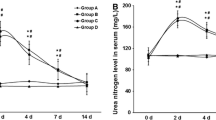Abstract
The use of hydroxyproline (HP) to generate hyperoxaluria in the rat is a problem because it is impossible to separate the effect of oxalate on renal injury from the effects of HP and the large array of metabolic intermediates formed when HP is converted to oxalate. Previously, the Dahl salt-sensitive (SS) and Brown Norway (BN) rat strains were studied to determine genetic control of resistance or susceptibility to HP-induced renal injury and crystal deposition. To develop a better model to induce hyperoxaluria without causing injury from HP metabolites, animals were fed a diet containing various levels of added oxalate (0, 1, 2, 3, or 5%). After 5 weeks rats were killed and the kidneys were removed for microscopic evaluation of tubule changes and crystal deposition. The 3 and 5% oxalate-fed groups had a substantial increase in urine oxalate, about 50 and 140 μmol/g body weight over controls, respectively. Both the SS and BN 3% oxalate-fed animals showed only slightly elevated tubule area and no crystal deposition. However, BN animals fed 5% oxalate had a dramatic increase in their percent tubule areas compared to control BN rats and treated SS rats. Crystal deposition in the kidneys was only observed in the 5% oxalate-fed groups. The BN kidneys demonstrated a threefold higher crystal deposition compared to oxalate-fed SS rats. We conclude that oxalate-supplemented food is a better method of producing hyperoxaluria in the rat than using HP which may introduce metabolic intermediates injurious to the kidney.





Similar content being viewed by others
References
Pak CY (2004) Medical management of urinary stone disease. Nephron Clin Pract 98:c49–c53
Evan A, Lingeman J, Coe FL, Worcester E (2006) Randall’s plaque: pathogenesis and role in calcium oxalate nephrolithiasis. Kidney Int 69(8):1313–1318
Marengo SR, Romani AM (2008) Oxalate in renal stone disease: the terminal metabolite that just won’t go away. Nat Clin Pract Nephrol 4(7):368–377
Wiessner JH, Garrett MR, Roman RJ, Mandel NS (2009) Dissecting the genetic basis of kidney tubule response to hyperoxaluria using chromosome substitution strains. Am J Physiol Renal Physiol 297(2):F301–F306. doi:10.1152/ajprenal.00009.2009
PhysGen. (2006) Program for Genomic Applications:Physiogenomics of stressors in derived consomic rats (online). (The Medical College of Wisconsin, http://pga.mcw.edu)
Knight J, Jiang J, Assimos DG, Holmes RP (2006) Hydroxyproline ingestion and urinary oxalate glycolate excretion. Kidney Int 70(11):1929–1934
Takayama T, Fujita K, Suzuki K, Sakaguchi M, Fujie M, Nagai E, Watanabe S, Ichiyama A, Ogawa Y (2003) Control of oxalate formation from l-hydroxyproline in liver mitochondria. J Am Nephrol 14:939–946. doi:10.1097/01.ASN.0000059310.67812.4F
Chiriboga J (1966) Purification and properties of oxalic acid oxidase. Arch Biochem Biophys 116:516–523
Acknowledgments
The work in this manuscript was supported by grants from the NIDDK DK064616 (N.S.M.), from Department of Veterans Affairs (N.S.M) as a VA Merit Award and a Senior Research Career Scientist Award. M. R. G. is supported by NIH/NHLBI HL09446 and funds from Advancing Healthier Wisconsin (AHW).
Author information
Authors and Affiliations
Corresponding author
Rights and permissions
About this article
Cite this article
Wiessner, J.H., Garrett, M.R., Hung, L.Y. et al. Improved methodology to induce hyperoxaluria without treatment using hydroxyproline. Urol Res 39, 373–377 (2011). https://doi.org/10.1007/s00240-011-0368-8
Received:
Accepted:
Published:
Issue Date:
DOI: https://doi.org/10.1007/s00240-011-0368-8




